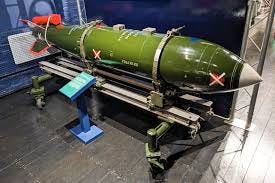On Deterrence, both Conventional and Nuclear
Ukraine needs an ace in its back pocket. It need not be nuclear.
President Zelensky recently described eventual Ukrainian NATO membership as an alternative to homegrown nuclear deterrence. His comments were falsely construed, in some quarters, as a threat to pursue nuclear weapons. Zelensky made the comparison to drive home the point that Ukraine seeks Western support instead, and is not pursuing nukes. Nuclear weapons are probably a bad idea, in the end—but the idea shouldn’t be taboo, and points toward much better options for conventional deterrence.
The nuclear question is an especially poignant one because Ukraine had thousands of warheads after the dissolution of the USSR. It relinquished those warheads in the 1990s amid trilateral negotiations among Kyiv, Moscow, and Washington. The US was gravely worried about nuclear proliferation, fearing that rogue actors might acquire weapons of mass destruction amid the chaos of Soviet collapse. The Clinton administration was betting heavily on Yeltsin, too, as Russia’s savior.
That combination led Washington to gloss over Ukrainian security concerns: the “Budapest Memorandum” promised respect for Ukrainian sovereignty, but included no actual promise of aid in case of Russian attacks. To be fair, Ukraine did receive financial benefits, the deal brought EU accession closer, and it wasn’t clear Ukraine could maintain and fire the weapons it had. It didn’t seem crazy at the time. In retrospect, though, it was likely an error. Ancillary provisions were especially foolish. Perhaps it was wise to centralize control over nuclear warheads in Moscow, but the deal also forced Ukraine to eliminate its Soviet-era strategic bomber fleet and its other delivery vehicles—cruise and ballistic missiles. All those have conventional, non-nuclear applications, and would be highly useful today.
Still, bygones are bygones. It may be true that Putin would not have invaded a nuclear-armed neighbor. But it is less clear how nuclear weapons help Kyiv now. Suppose we could snap our fingers, eliminate the years of necessary development (years the West could dramatically shorten), and re-arm Ukraine. Ukraine could try to use its nuclear weapons in two main ways, but each method has grave weaknesses.
First, of course, Ukraine could threaten a strategic strike on Russian cities. But that threat only works if it’s credible, and it will not be credible under most circumstances. It would result in mutually assured destruction, so Ukraine would never try it except in case of gravest peril—in case Kyiv itself is about to fall, maybe. A nuclear deterrent centered on mutually assured destruction would not help Ukraine stabilize its lines in the east.
Second, Ukraine could try tactical strikes on Russian lines in the east. But Russia would retaliate, and would do so with superior numbers of weapons and more delivery options. Besides, Ukraine might not want to strike its own territory, even if Russia has already ravaged it. Finally, this war is highly dispersed—it lacks large concentrations of troops and armor. More precision, not less, is key. So tactical nukes might not even work very well. At best, a tactical exchange would freeze the current frontlines, but at the cost of the global taboo on nuclear use.
That doesn’t make nuclear weapons worthless. At the very least, Russia ought to fear a nuclear-armed Ukraine. If Putin can engage in saber-rattling, so can America. The US should publicly float the possibility of support for a Ukrainian nuclear program.
But there is a far better option: a serious conventional deterrent. Ukraine doesn’t need nuclear weapons. It needs thousands of long-range cruise missiles and ballistic missiles, and tens of thousands—even hundreds of thousands—of long-range suicide drones. America should provide them. They’d work much better than nuclear weapons because the threat of use is much more credible, and needn’t remain a threat at all. Ukraine should use them to conduct long-range strikes every day—as it now does with drones, though with lesser volume. So far, long-range strike deterrence works: Ukraine re-opened the Black Sea (and, for a while, forced a grain deal with Russia) by relentlessly targeting Russian ships. Now, new reports suggest that both sides are considering a moratorium on energy infrastructure attacks, after Ukraine successfully pounded Russian oil infrastructure for months with home-made drones. Enhanced Ukrainian strike capabilities would have the same effect, but on a far larger scale.
Given Ukraine’s manpower issues, that kind of deterrent might be the best way to force Putin to the table. It’s a shame that Washington remains three steps behind, still debating whether to allow the use of American weapons on Russian soil at all. Even in response to the arrival of North Korean troops, the Pentagon merely promised not to impose any new restrictions—an option that should never have been on the table, and one that gets escalation management precisely backwards. Putin needs to fear Ukraine, and needs to fear the West, too. Ukrainian nuclear deterrence remains unwise, but it shouldn’t be taboo—and a serious conventional deterrent is key to ending this war.
Jonathan Meilaender is a JD candidate at Harvard Law and is concurrently engaged in a Master’s program in German and European studies at Georgetown University. He received his BA in Politics from Saint Vincent College where he was also Editor-in-Chief of the Saint Vincent College Review. @JMeilaender




